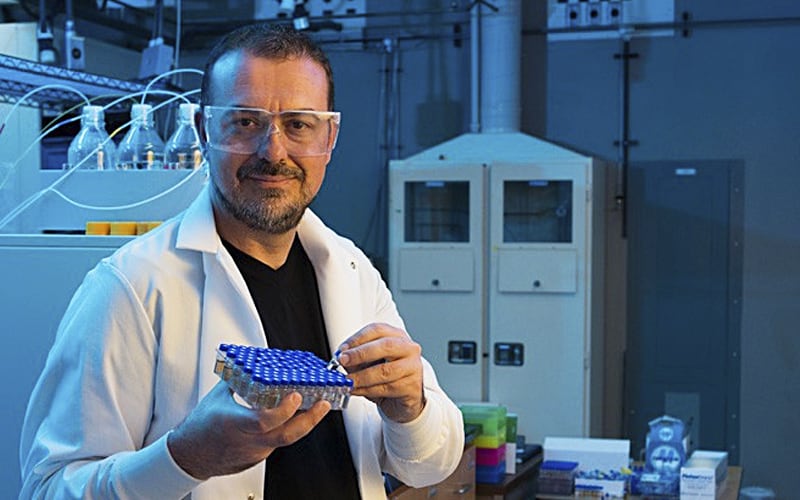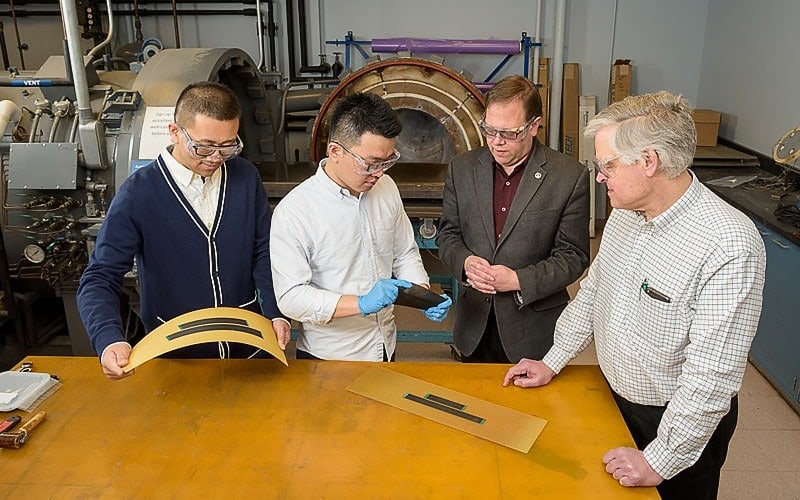 Research & Discovery
Research & Discovery
A Blog Devoted to UD Innovation, Excellence and Scholarship
Research & Discovery
A Blog Devoted to UD Innovation, Excellence and Scholarship
Protecting buildings from earthquakes
ABOVE: Jovan Tatar (left), assistant professor in the Department of Civil and Environmental Engineering at the University of Delaware and Shafique Ahmed, a doctoral candidate in the Department of Civil and Environmental Engineering at UD, discuss a fiber-reinforced polymer composite on the boundary element of a building. | Photo by Jovan Tatar
Engineering professor studies effectiveness of retrofits to strengthen concrete structures
Jovan Tatar, an assistant professor of civil and environmental engineering at the University of Delaware and an affiliated faculty in the Center for Composite Materials, recently visited Alaska to study how this magnitude 7.1 earthquake affected buildings with externally bonded fiber-reinforced polymer composite retrofits. By assessing how these buildings held up, Tatar and his collaborators can help other engineers construct buildings that stand up to natural disasters.
The composite retrofits are a promising, relatively inexpensive technology that can strengthen buildings, bridges and other existing structures made of reinforced concrete. Composites are made by combining one or more materials together to create a new material with entirely different properties. The composite materials Tatar is studying are stronger than steel and can be applied to structures in a thin layer, kind of like wallpaper or a bandage to the surface of the building. Other retrofitting methods can be more expensive, more difficult to install, and weighty — putting extra stress on the structure’s foundation.
Several structures in Alaska have the composite retrofits, presenting Tatar and his colleagues the opportunity to be the first research group to test the effectiveness of these materials post-earthquake in the U.S. Through visual inspections and thermal imaging to both the interiors and exteriors of commercial and residential structures, they looked for signs of damage, such as cracks or bubbles, on the retrofits and collected samples for chemical analysis.
Tatar wants to understand how the durability of these retrofits affects the earthquake resilience of structures. “When engineers design these retrofits, they have to make assumptions of their behavior based on laboratory data and experiments, but there is not much real-world data out there,” said Tatar. “Our analysis will serve as a benchmark to check some of these assumptions against.”
Some retrofits were over 15 years old, allowing the team to analyze the effects of long-term use in a subarctic environment.
Tatar and Shafique Ahmed, a doctoral candidate at UD, worked with colleagues at the National Institute of Standards and Technology (NIST) and the Director of Engineering at QuakeWrap, Inc. on this project as part of the National Earthquake Hazards Reduction Program (NEHRP). NIST promotes U.S. innovation and industrial competitiveness by advancing measurement science, standards, and technology in ways that enhance economic security and improve our quality of life. NIST is designated by the U.S. Congress as the statutory Lead Agency for NEHRP, which has four participating agencies: the Federal Emergency Management Agency (FEMA), NIST, the National Science Foundation (NSF), and the U.S. Geological Survey (USGS). Tatar has received a grant from NSF for this project.





